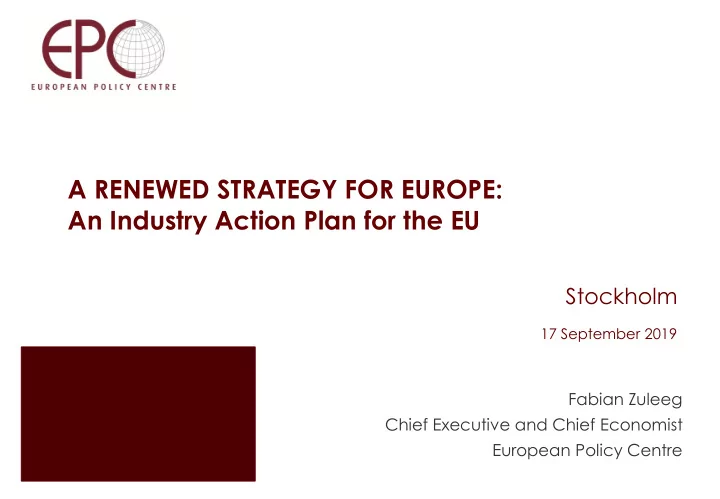

A RENEWED STRATEGY FOR EUROPE: An Industry Action Plan for the EU Stockholm 17 September 2019 Fabian Zuleeg Chief Executive and Chief Economist European Policy Centre
Introduction EPC Task Force Pan-European project (2018-19) Issues: - Drivers for industrial transformation + innovative responses - European vision + common objectives - Added value of coordinated action - Strategy with concrete measures - Carrots + sticks Multi-stakeholder: businesses, NGOs, foundations, regional and member state representations, representatives of EU institutions Publication: An Industry Action Plan for the EU ➢ www.epc.eu 2
A new EU strategy expected by next Commission Current EU approach, not enough: EU’s new “Industrial Policy Strategy” September 2017 Call from Friends of Industry, Paris 18 December 2018 ‘ N o’ to the Alstom -Siemens merger: A new German strategy and the Franco- German ‘Manifesto’ European Council 21- 22 March: “ the Commission is invited to present, by the end of 2019, a long-term vision for the EU’s industrial future, with concrete measures to implement it” ➢ Von der Leyen’s Political Guidelines: “To help drive the change we need, I will put forward my plan for a future-ready economy, our new industrial strategy ”.
Industry is crucial for Europe Approximately 21 % of the EU’s GDP One of the largest employer: 20 % and 36 million jobs directly And servicification : manufacturing creates 0.5-2 jobs in services Key driver for innovation, productivity, growth: reps. 65% of R&D Accounts for 80% of the EU’s exports
But facing major challenges and megatrends (1) Slowdown in trade, distorted competition US: tariffs impacting global growth, WTO crisis Brexit ‘Made in China’ 2025: Europe is feeling the heat, massive subsidies, forced tech transfers etc.
But facing major challenges and megatrends (2) Digital technologies transforming industry: Industry 4.0 Productivity gains: global productivity growth est. 0.8%-1.4% annually Automation of ‘physical’ and ‘predictable’, but with future AI also ‘managerial’ and ‘unpredictable’ Create new jobs: cybersecurity, data analysts, hardware manufacturers, and coders Increasingly reliant on GVCs and innovation EU industry traditionally on high added value end of GVCs Innovation crucial for competitive advantage Infrastructure: new business models, human capital, skills, IPRs, FDIs etc.
But facing major challenges and megatrends (3) Need for a sustainable industry: Calls for and lower emissions and climate neutrality by 2050 Will require massive efforts to reach Paris Agreement and UN SDGs ‘Industrial processes and product use’ represent 8% of EU GHG emissions (9% in 1990) Industry-related activities also responsible for emissions within ‘fuel combustion and fugitive emissions from fuels’ (54%) and transport sector (25%). Growing competition over human and natural resources European dependence on critical raw materials from a few third-countries ‘Skills - shortage crisis’: ICT professionals, STEM, teachers, health sector
EU-specific challenges Lack of European digital champions, not enough investments in AI, IoT, and advanced manufacturing, implications for ‘technological sovereignty’ Making the Single Market work: services, enforcement, re-emergence of barriers, ‘gold - plating’, no Digital Single Market Need to move away from academic research to better involve/incentivise companies EU financial sector is ill-suited to support innovative & new firms: little risk- taking and mostly public money (vs. US) ➢ Need to go from a more passive (even if crucial) enforcing competition rules (Vestager I) to more actively supporting EU industry (Vestager II as EVP)
Why an EU strategy? 1. In current global context: need for more strategic thinking (strategic autonomy agenda) 2. Role for EU coordination: danger of EUMS reacting to global pressures with ‘protective’ national initiatives → fragmentation 3. Consistent response to foreign interventions and react to the ‘protectionist' measures that have been adopted as part of foreign industrial policies 4. Protect EU interests within a rules-based system (e.g. antidumping policies or investment screening) ➢ added value of an EU industrial strategy by complementing and coordinating national policies, not by replacing them
What can an EU Action Plan deliver? A vision for 2030: 1. Sustainability 2. Competitiveness 3. Strategic Autonomy An Action Plan should create the conditions for European industry to: better responding to distorted competition, leveraging market power and moving towards more technological sovereignty, contribute to high-quality employment, R&D and growth, by increasing participation within highly innovative GVCs, become a global leader in sustainable, smart health and industrial AI value chains, become fully climate-neutral by 2050. Governance: the Council’s High -Level Group on Competitiveness and Growth, in cooperation with the Commission
Recommendations: 5 policy aims of an Action Plan 1. Making the Single Market work, including competition policy ➢ A list of reforms towards 2022: services, public procurements and standards ➢ An independent competition authority, modernizing competition rules 2. Better innovation and digital policy ➢ Increase funds to Digital Europe Programme, InvestEU and Connecting Europe ➢ Earmark Horizon Europe funds for industrial innovation ➢ Promote Important Projects of Common European Interests 3. Acting strategically and enforcing reciprocity ➢ Introduce binding measures within FDI screenings ➢ Adopt the International Public Procurement tool ➢ Enhance Europe’s economic diplomacy, secure access to raw materials 4. Ensuring a fair and inclusive industrial transition ➢ A long-term territorial and place sensitive strategy, supporting vulnerable workers and regions ➢ Stimulate private investments in digital skills 5. Climate-proofing industry ➢ A climate neutrality roadmap for 2050 ➢ Create lead markets for low emission industrial products and services
Contact Fabian Zuleeg Chief Executive and Chief Economist, European Policy Centre F.Zuleeg@epc.eu
Recommend
More recommend